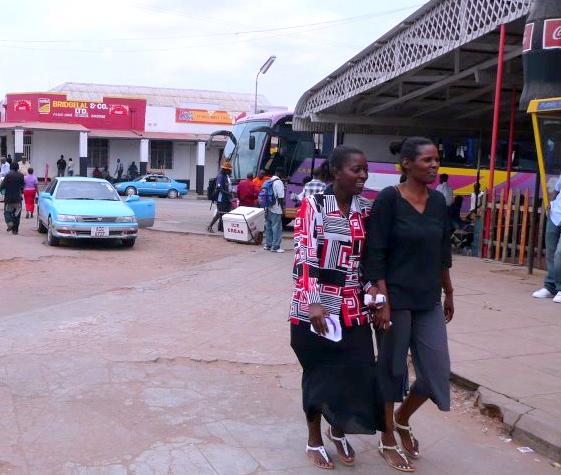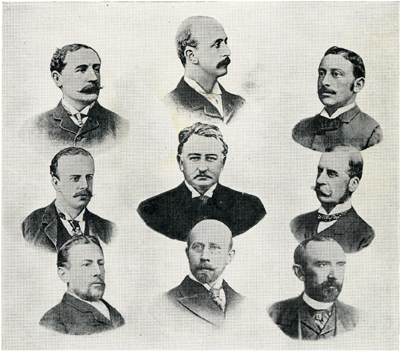|
Beit Bridge
Beitbridge is a border town in the province of Matabeleland South, Zimbabwe. The name also refers to the border post and bridge spanning the Limpopo River, which forms the political border between South Africa and Zimbabwe. The border on the South African side of the river is also named Beitbridge. Background The town lies just north of the Limpopo River about 1 km from the Alfred Beit Road Bridge which spans the Limpopo between South Africa and Zimbabwe. The main roads are the A6 highway to Bulawayo and the Victoria Falls, being and away respectively and the A4 to Masvingo and Harare. According to the 2012 population census, the town had a population of 41,767 dominated by the Venda and Ndebele people. There is a sizable percentage of Shona people from other provinces. This is a busy border post with traders from all over Zimbabwe. The Beitbridge border post is the busiest road border post in Southern Africa, and is best avoided during busy border-crossing sea ... [...More Info...] [...Related Items...] OR: [Wikipedia] [Google] [Baidu] |
Town
A town is a type of a human settlement, generally larger than a village but smaller than a city. The criteria for distinguishing a town vary globally, often depending on factors such as population size, economic character, administrative status, or historical significance. In some regions, towns are formally defined by legal charters or government designations, while in others, the term is used informally. Towns typically feature centralized services, infrastructure, and governance, such as municipal authorities, and serve as hubs for commerce, education, and cultural activities within their regions. The concept of a town varies culturally and legally. For example, in the United Kingdom, a town may historically derive its status from a market town designation or City status in the United Kingdom, royal charter, while in the United States, the term is often loosely applied to incorporated municipality, municipalities. In some countries, such as Australia and Canada, distinction ... [...More Info...] [...Related Items...] OR: [Wikipedia] [Google] [Baidu] |
A4 Road (Zimbabwe)
The A4 is a highway, also known as the R1 Highway, which runs between Beitbridge and Harare. From Beitbridge it passes through Rutenga, Ngundu, Masvingo, Mvuma, Chivhu before reaching Harare. As a national road it is known as the A4 Highway and as a regional road corridor it is known as the R1 Highway.Source: [Map 9.2 Road Transport Network of Zimbabwe.] Background Pan African Highway Link The A4/R1 Highway together with the R3 Road (Zimbabwe), R3 Highway which runs from Harare to Chirundu, Zimbabwe, Chirundu forms the Chirundu-Beitbridge Regional Road Corridor, which is part of the North-South Corridor known as the Cape to Cairo Road (Chirundu to Beitbridge 897 kilometres, 557 miles). Rehabilitation The highway is set for rehabilitation as part of the ongoing national roads project and as an important link to the Trans-African Highway. The R1 Road (Zimbabwe), R1 is the most direct link between the capital cities of Harare and Pretoria, and together with the R3 Road (Zimbab ... [...More Info...] [...Related Items...] OR: [Wikipedia] [Google] [Baidu] |
Toll Bridge
A toll bridge is a bridge where a monetary charge (or '' toll'') is required to pass over. Generally the private or public owner, builder and maintainer of the bridge uses the toll to recoup their investment, in much the same way as a toll road. History The practice of collecting tolls on bridges harks back to the days of ferry crossings where people paid a fee to be ferried across stretches of water. As boats became impractical to carry large loads, ferry operators looked for new sources of revenue. Having built a bridge, they hoped to recoup their investment by charging tolls for people, animals, vehicles, and goods to cross it. The original London Bridge across the river Thames opened as a toll bridge, but an accumulation of funds by the charitable trust that operated the bridge ( Bridge House Estates) saw that the charges were dropped. Using interest on its capital assets, the trust now owns and runs all seven central London bridges at no cost to taxpayers or users. I ... [...More Info...] [...Related Items...] OR: [Wikipedia] [Google] [Baidu] |
South African Railways
Transnet Freight Rail is a Rail transport in South Africa, South African rail transport company, formerly known as Spoornet. It was part of the South African Railways and Harbours Administration, a state-controlled organisation that employed hundreds of thousands of people for decades from the first half of the 20th century and was widely referred to by the initials SAR&H (SAS&H in Afrikaans). Customer complaints about serious problems with Transnet Freight Rail's service were reported in 2010. Its head office is in Inyanda House in Parktown, Johannesburg. History Railways were first developed in the area surrounding Cape Town and later in Durban around the 1840s. The first line opened in Durban on 27 June 1850. The initial network was created to serve the agricultural production area between Cape Town and Wellington. The news that there were gold deposits in the Transvaal Republic moved the Cape Colony Government (supported by British Government) to link Kimberley as soon as ... [...More Info...] [...Related Items...] OR: [Wikipedia] [Google] [Baidu] |
Rhodesia Railways
The National Railways of Zimbabwe (NRZ), formerly Rhodesia Railways (RR), is a Bulawayo headquartered state-owned enterprise that operates the country's national railway system. It was established in 1893 and is governed by an Act of Parliament. It has a commercial-administrative center in Harare and a supply center in Gweru. The Zimbabwean railway system was largely constructed during the 20th century. History NRZ's history begins with the creation of the Bechuanaland Railway Company on May 24, 1893. It was renamed Rhodesia Railways Ltd (RR) on July 1, 1899.Günter Krause. ''Eisenbahnmuseum Livingstone (Sambia) und die Zambesi Saw Mills Railways''. 2 Ed. 2018. At the same time, on April 13, 1897, the Mashonaland Railway Company (MRC) was founded. On March 1, 1905 the small Ayrshire Gold Mine & Lomangundi Railway Company — which had been founded in 1900 — merged with MRC. A similar event would occur with the Beira & Mashonaland Railway (also founded in 1900), which m ... [...More Info...] [...Related Items...] OR: [Wikipedia] [Google] [Baidu] |
British South Africa Company
The British South Africa Company (BSAC or BSACo) was chartered in 1889 following the amalgamation of Cecil Rhodes' Central Search Association and the London-based Exploring Company Ltd, which had originally competed to capitalize on the expected mineral wealth of Mashonaland but united because of common economic interests and to secure British government backing. The company received a Royal Charter modelled on that of the British East India Company. Its first directors included The 2nd Duke of Abercorn, Rhodes himself, and the South African financier Alfred Beit. Rhodes hoped BSAC would promote colonisation and economic exploitation across much of south-central Africa, as part of the "Scramble for Africa". However, his main focus was south of the Zambezi, in Mashonaland and the coastal areas to its east, from which he believed the Portuguese could be removed by payment or force, and in the Transvaal, which he hoped would return to British control. It has been suggested that ... [...More Info...] [...Related Items...] OR: [Wikipedia] [Google] [Baidu] |
Cecil Rhodes
Cecil John Rhodes ( ; 5 July 185326 March 1902) was an English-South African mining magnate and politician in southern Africa who served as Prime Minister of the Cape Colony from 1890 to 1896. He and his British South Africa Company founded the southern African territory of Rhodesia (region), Rhodesia (now Zimbabwe and Zambia), which the company named after him in 1895. He also devoted much effort to realising his vision of a Cape to Cairo Railway through British territory. Rhodes set up the Rhodes Scholarship, which is funded by his estate. The son of a vicar, Rhodes was born at Rhodes Arts Complex, Netteswell House, Bishop's Stortford, Hertfordshire. A sickly child, he was sent to South Africa by his family when he was 17 years old in the hope that the climate might improve his health. He entered the diamond trade at Kimberley, Northern Cape, Kimberley in 1871, when he was 18, and with funding from Rothschild & Co, began to systematically buy out and consolidate diamond mines ... [...More Info...] [...Related Items...] OR: [Wikipedia] [Google] [Baidu] |
De Beers
The De Beers Group is a South African–British corporation that specializes in the diamond industry, including mining, exploitation, retail, inscription, grading, trading and industrial diamond manufacturing. The company is active in open-pit, underground, large-scale alluvial and coastal mining. It operates in 35 countries, with mining taking place in Botswana, Namibia, South Africa, and Canada. It also has an artisanal mining business, Gemfair, which operates in Sierra Leone. From its inception in 1888 until the start of the 21st century, De Beers controlled 80% to 85% of rough diamond distribution and was considered a monopoly. By 2000, the company's control of the world diamond supply decreased to 63%. The company was founded in 1888 by British businessman Cecil Rhodes, who was financed by the South African diamond magnate Alfred Beit and the London-based N M Rothschild & Sons bank. In 1926, Ernest Oppenheimer, a German immigrant to Britain and later South Africa who ... [...More Info...] [...Related Items...] OR: [Wikipedia] [Google] [Baidu] |
Alfred Beit
Alfred Beit (15 February 1853 – 16 July 1906) was an Anglo-German gold and diamond magnate in South Africa, and a major donor and profiteer of infrastructure development on the African continent. He also donated much money to university education and research in several countries, and was the "silent partner" who structured the capital flight from post-Boer War South Africa to Rhodesia. Beit's assets were structured around the so-called Corner House Group, which through its holdings in various companies controlled 37 per cent of the gold produced at the Witwatersrand's goldfields in Johannesburg in 1913.See chapter 12 in Rönnbäck & Broberg (2019) Capital and Colonialism. The Return on British Investments in Africa 1869-1969 (Palgrave Studies in Economic History) Life and career Born and brought up in , |
Deutscher Wetterdienst
The () or DWD for short, is the German Meteorological Service, based in Offenbach am Main, Germany, which monitors weather and meteorological conditions over Germany and provides weather services for the general public and for nautical, aviation, hydrometeorological or agricultural purposes. It is attached to the Federal Ministry for Transport. The DWDs principal tasks include warning against weather-related dangers and monitoring and rating climate changes affecting Germany. The organisation runs atmospheric models on their supercomputer for precise weather forecasting. The DWD also manages the national climate archive and one of the largest specialised libraries on weather and climate worldwide. History The DWD was formed on 11 November 1952 when the weather services of the western occupation zones were merged. In 1954, the Federal Republic of Germany joined the World Meteorological Organization (WMO). In 1990, following the reunification, the weather services of t ... [...More Info...] [...Related Items...] OR: [Wikipedia] [Google] [Baidu] |
World Meteorological Organization
The World Meteorological Organization (WMO) is a List of specialized agencies of the United Nations, specialized agency of the United Nations responsible for promoting international cooperation on atmospheric science, climatology, hydrology and geophysics. The WMO originated from the International Meteorological Organization (IMO), a nongovernmental organization founded in 1873 as a forum for exchanging weather data and research. Proposals to reform the status and structure of the IMO culminated in the World Meteorological Convention of 1947, which formally established the World Meteorological Organization. The Convention entered into force on 23 March 1950, and the following year the WMO began operations as an intergovernmental organization within the UN system. The WMO is made up of 193 countries and territories, and facilitates the "free and unrestricted" exchange of data, information, and research between the respective meteorological and hydrological institutions of its m ... [...More Info...] [...Related Items...] OR: [Wikipedia] [Google] [Baidu] |
Northern Ndebele People
The Northern Ndebele people (; ; ) are a Nguni ethnic group native to Southern Africa. Significant populations of native speakers of the Northern Ndebele language (siNdebele) are found in Zimbabwe and as amaZulu in South Africa. They differ from Southern Ndebele people who speak isiNdebele of KwaNdebele. Regional classification The Northern Ndebele language spoken by the Ndebele people of Zimbabwe is generally the same as the isiZulu language spoken by the Zulu people of South Africa with a few pronunciation and word meaning differences. Northern Ndebele spoken in Zimbabwe and Southern Ndebele (or Transvaal Ndebele) spoken in South Africa are separate but related languages with some degree of mutual intelligibility, although the former is more closely related to Zulu. Southern Ndebele, while maintaining its Nguni roots, has been influenced by the Sotho languages. Etymology The Northern Ndebele, specifically the Khumalo (amaNtungwa) people under Mzilikazi, were origi ... [...More Info...] [...Related Items...] OR: [Wikipedia] [Google] [Baidu] |










